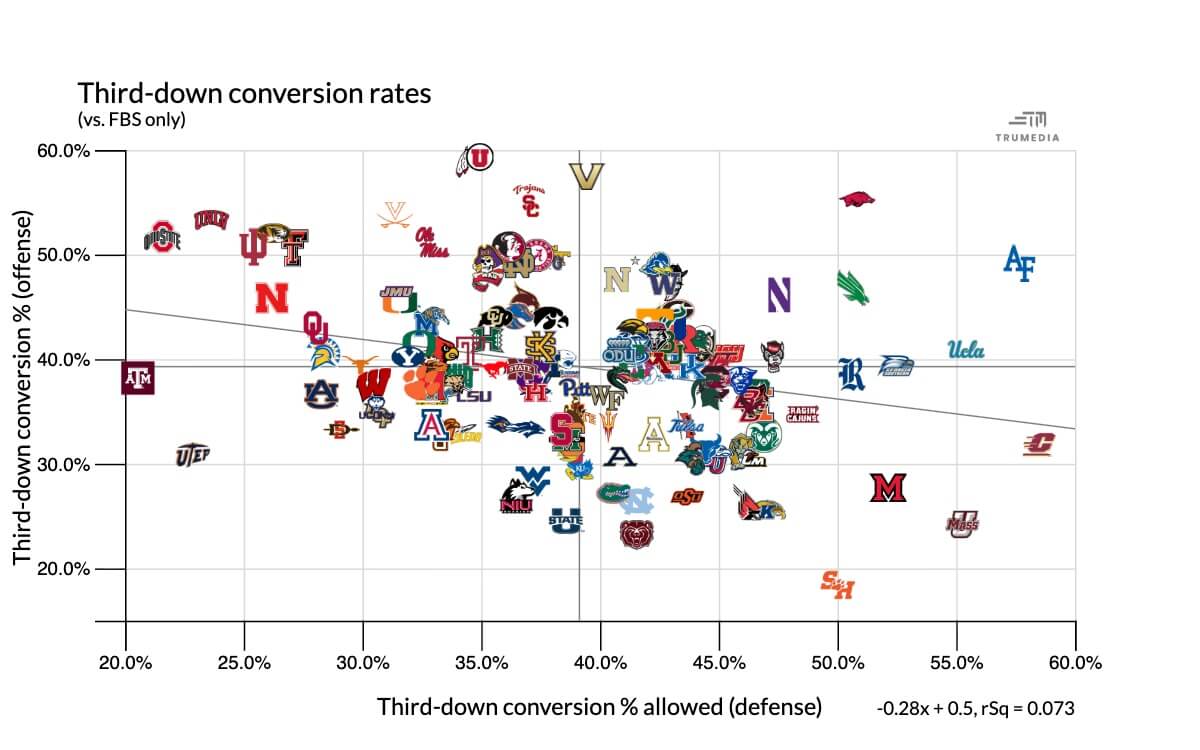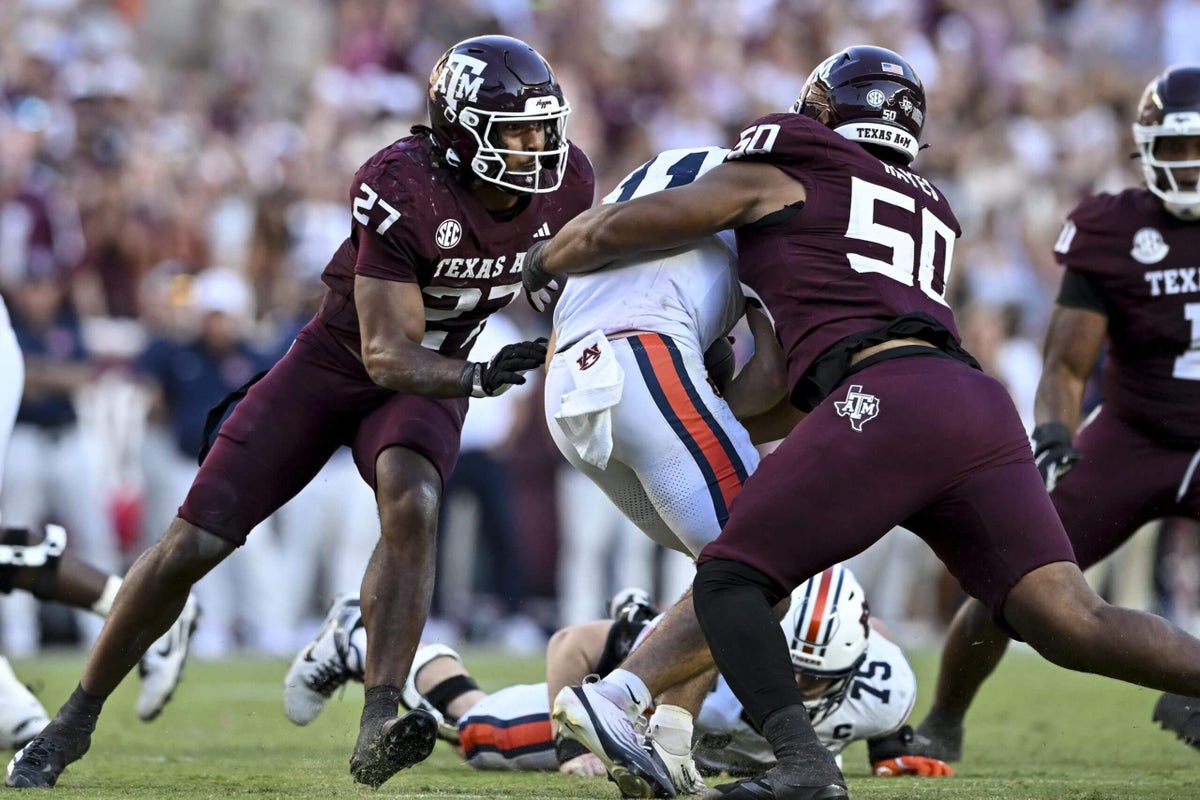Texas A&M is off to its best start in nine years and in the top four of the Associated Press poll for the first time since 2020.
The Aggies started the season displaying an explosive offense, scoring more than 40 points in each of their first three wins, but their defense has been the story in the last three weeks, particularly on third downs.
In three SEC games, Texas A&M has allowed just two third-down conversions on 33 attempts, a minuscule 6.1 percent conversion rate for opponents. It’s by far the best rate in the country in the last three weeks and is a big reason the Aggies rank No. 1 this season in third-down defense — a 20.8 percent success rate that is the lowest in at least the past 10 years.
Third-down defense (vs. FBS)
TeamConv.Att.Conv. %
16
78
20.5%
14
65
21.5%
16
70
22.9%
13
55
23.6%
16
63
25.4%
17
65
26.2%
16
61
26.2%
20
74
27.0%
21
75
28.0%
24
85
28.2%
Defensive third-down success has been a forte for Mike Elko at Texas A&M, dating to his time as the defensive coordinator for the Aggies. During his tenure as an assistant, from 2018 through 2021, A&M ranked in the top 25 nationally in third-down defense each year and three times placed in the top 15.
Philosophically, it’s a point of emphasis for Elko. In 2021, he spoke at length to Texas high school coaches at the Angelo Football Clinic in San Angelo, Texas, about his approach, which focuses heavily on defining down-to-down success and failure for his defense daily in practice.
The goal on first down, Elko said, is to hold opponents to 3 or fewer yards.
“When you go out there for the first day of spring ball and the offense runs a play on first-and-10, if they got 4 yards, we lost,” Elko said. “We didn’t win, we didn’t get the job done.”
Second down, he considered a “half down,” meaning the offense wants to get at least half the yardage needed for a conversion, while his defense’s goal is to prevent a gain of half the distance.
On third down, the yardage dictates the attack plan. Elko said third-and-11 or more yards “should be a 90-95 percent stop rate for us,” third-and-7-to-10 yards should be an 85-90 percent win rate, third-and-4-to-6 yards is a “coin flip,” and third-and-3 or less favors the offense.
In 2025, the Aggies have come close to hitting Elko’s desired success rates in each of those areas. According to TruMedia, on third-and-11 or more, A&M has held teams to 3-of-26 (11.5 percent). On third-and-7-to-10 yards, A&M held offenses to 6-of-30 (20 percent) and on third-and-3 or less, the Aggies have allowed conversions on six of 10 attempts.
But A&M’s best work has been done in the third-and-4-to-6-yard range. In that middle distance, which Elko called a coin flip, A&M has allowed just one conversion in 12 attempts (8.3 percent), which is No. 1 in the FBS in those situations. The national average conversion rate allowed this season on third-and-4-to-6 yards is 40.8 percent.
Third-down defense, 4-6 yards
A key factor in A&M’s third-down success is what the Aggies are doing on second down. A&M is near the middle of the pack on first down, allowing 5.7 yards per play (70th in the FBS). But on second down, the Aggies allow only 4.4 yards per play, which is 19th nationally. Per TruMedia, A&M is 10th in defensive success rate (63.7 percent), which is the percentage of plays a defense allows fewer than half the yards needed on first and second down and prevents first downs on third and fourth.
The average distance offenses have faced on third down against the Aggies this season is 9.3 yards. That’s the longest in the FBS, making it easier on A&M to get those third-down stops.
Elko credits his run defense, which allows just 3.3 yards per rush (22nd nationally against FBS teams).
“If you look at the third-and-off yardage situations that we’ve been able to put people in, a lot of that is a testament to the run defense and the ability to just keep people off schedule,” Elko said Monday. “If people can run the ball for 5, 6 yards and stay in that third-and-3, third-and-4 world, I’m sure we’re not talking about the success that we’re having on third-down defense. A large part of the success is the distance — the distance plays a huge role and I think a large part of that is tied into your run defense.”
Defensive average third-down distance
But who has been the best on third-and-short? Third-and-3 or less is the hardest to stop, which FBS offenses are converting at a 62.6 percent rate on average. Three defenses have been exceptionally tough to convert against in this area, allowing fewer than 40 percent conversions on third-and-short: UNLV, UTEP and Nebraska. And two of the top three teams in the AP poll (Ohio State and Indiana) are in the top 10 in this metric.
Third-down defense, 3 yards or less
TeamConv.Att.Conv. %
6
21
28.6%
10
27
37.0%
6
16
37.5%
8
20
40.0%
8
20
40.0%
7
17
41.2%
6
14
42.9%
11
25
44.0%
10
22
45.5%
11
24
45.8%
Coaches often preach the importance of getting off the field on third down and the best-case scenario for that is doing it on the first series of downs a defense faces. Three-and-outs are a defensive coordinator’s best friend.
Despite their elite third-down success, the Aggies do not rank in the top 10 nationally in three-and-out percentage (the percentage of opponents’ offensive drives that fail to yield a first down or a score). The Aggies are good in that area, getting three-and-outs on 40.3 percent of drives against FBS opponents, the 16th-best rate nationally. Oregon (54.2 percent) has been the best at getting three-and-outs against FBS opponents. Oklahoma (53.3 percent) is the only other team above 50 percent.
Defensive three-and-out rate (vs. FBS)
For offenses, the best chance at third-down success is to keep the distances short or avoid third down altogether by moving the chains on first and second. The three teams that have the shortest average distance to go on third downs offensively — Utah, Indiana and Missouri — are a combined 16-2.
Offensive average third-down distance
The offenses that are best at avoiding third-down situations aren’t surprising. Seven of the top 10 teams in yards per play against FBS opponents are also in the top 10 in avoiding third downs, running a low percentage of plays on third.
Offensive rate of third-down plays
So who has the best of both worlds? Unsurprisingly, several top-10 teams are among the best in both third-down offense and third-down defense. Ohio State, Indiana, Texas Tech, Ole Miss, Alabama and Miami are all among the above-average teams in both categories. But so is Utah, USC, UNLV, Nebraska, Virginia, James Madison, Memphis, Oklahoma and Western Kentucky, among others.


